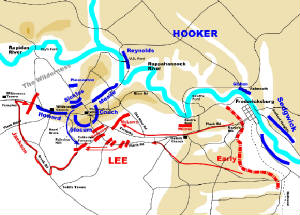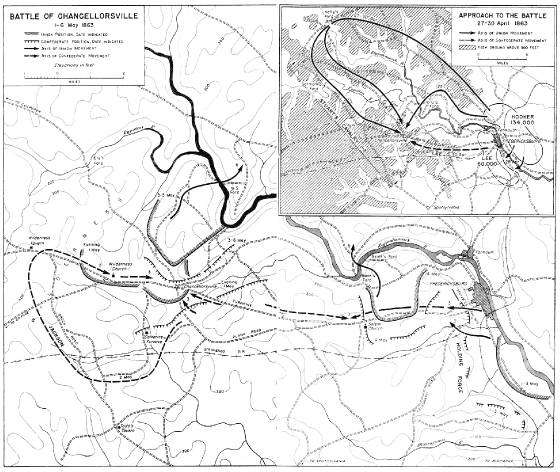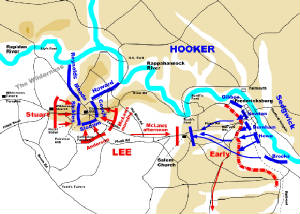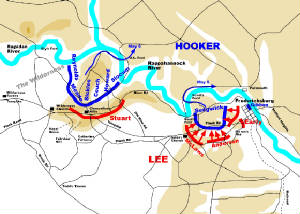|
CHANCELLORSVILLE TIMELINE
The
Beginning
April
26 - May 1, 1863
| Chancellorsville Battlefield on May 1 - 2 |

|
| (Click to Enlarge Map) |
Morale in the Federal Army of the Potomac rose with the appointment
of Joseph Hooker to command. Hooker reorganized the army and formed a cavalry corps. He wanted to strike at Lee's army while
a sizable portion was detached under Longstreet in the Suffolk
area. The Federal commander left a substantial force at Fredericksburg
to tie Lee to the hills where Burnside had been defeated. Another Union force disappeared westward, crossed the Rapidan and
Rappahannock rivers, and converged on Fredericksburg from
the west. The Federal cavalry would open the campaign with a raid on Lee's line of communications with the Confederate capital
at Richmond. Convinced that Lee would have to retreat, Hooker
trusted that his troops could defeat the Confederates as they tried to escape his trap.
On April 29, Hooker's cavalry and three army corps crossed Kelly's Ford.
His columns split, with the cavalry pushing to the west while the army corps secured Getmanna and Ely's fords. The next day
these columns reunited at Chancellorsville. Lee reacted to the news of the Federals in the
Wilderness by sending General Richard H. Anderson's division to investigate. Finding the Northerners massing in the woods
around Chancellorsville; Anderson commenced the construction of earthworks at Zoan Church. Confederate reinforcements under
Stonewall Jackson marched to help block the Federal advance, but did not arrive until May 1. The Confederates had no intention
of retreating as Hooker had predicted.
Hooker's troops rested at Chancellorsville
after executing what is often considered to be the most daring march of the war. They had slipped across Lee's front undetected.
To some the hardest part of the campaign seemed to be behind them; to others, the most difficult had yet to be encountered.
The cavalry raid had faltered in its initial efforts and Hooker's main force was trapped in the tangles of the Wilderness
without any cavalry to alert them of Lee's approach.
April 26: Federal I and VI Corps cross the river and demonstrate against Lee's Fredericksburg
defenses
April 27: Federal V, XI and XII Corps concentrate, preparing to move upriver.
April 29: Federals cross, Kelly, Ford against slight opposition before splitting
their columns.
April 29. Meade's V Corps secures Ely's Ford during the evening.
April 29: Howard's XI Corps and Slocomb's XII Corps cross Germanna Ford during the
evening.
April 30: Sykes Division of V Corps uncovers U.S. Ford for the two Federal corps
to cross.
April 30: Hooker reunites, the right wing of the Army of the Potomac.
April 30: J.E.B. Stuart's Confederate cavalry clings to the Federal column, sending
Lee information as to its strength.
April 30 - May 1: Lee divides his army, leaving Early at Fredricksburg while the
remainder moves toward Chancellorsville.
CHANCELLORSVILLE TIMELINE
The Conclusion
May 1-6, 1863
| Chancellorsville Timeline Battle Map, May 1 - 6 |

|
| (Chancellorsville Battlefield) |
| Chancellorsville Battlefield on May 3 |

|
| (Click to Enlarge Map) |
As the Federal army converged on Chancellorsville, General Hooker expected
Lee to retreat from his forces, which totaled nearly 115,000. Although heavily outnumbered with just under 60,000 troops -
Lee had no intention of retreating. The Confederate commander divided his army: one part remained to guard Fredericksburg, while the other raced west to meet Hooker's advance. When the van of Hooker's
column clashed with the Confederates' on May 1, Hooker pulled his troops back to Chancellorsville,
a lone tavern at a crossroads in a dense wood known locally as The Wilderness. Here Hooker took up a defensive line, hoping
Lee's need to carry out an uncoordinated attack through the dense undergrowth would leave the Confederate forces disorganized
and vulnerable.
To retain the initiative, Lee risked dividing his forces still further, 'retaining
two divisions to focus Hooker's attention, while Stonewall Jackson marched the bulk of the Confederate army west across the
front of the Federal line to a position opposite its exposed right flank. Jackson
executed this daring and dangerous maneuver throughout the morning and afternoon of May 2. Striking two hours before dusk,
Jackson's men routed the astonished Federals in their camps.
In the gathering darkness, amid the brambles of the Wilderness, the Confederate line became confused and halted at 9 p.m.
to regroup. Riding in front of the lines to reconnoiter, Stonewall Jackson was accidentally shot and seriously wounded by
his own men. Later that night, his left arm was amputated just below the shoulder.
| Chancellorsville Battlefield on May 4 |

|
| (Click to Enlarge Map) |
On May 3, Jackson's successor, General J.E.B. Stuart, initiated the
bloodiest day of the battle when attempting to reunite his troops with Lee's. Despite an obstinate defense by the Federals,
Hooker ordered them to withdraw north of the Chancellor House. The Confederates were converging on Chancellorsville to finish
Hooker when a message came from Jubal Early that Federal troops had broken through at Fredericksburg.
At Salem Church, Lee threw a cordon around
these Federals, forcing them to retreat across the Rappahannock. Disappointed, Lee returned
to Chancellorsville, only to find that Hooker had also retreated across the river.
Chancellorsville is considered Lee's greatest
victory, although the Confederate commander's daring and skill met little resistance from the inept generalship of Joseph
Hooker. Using cunning, and dividing their forces repeatedly, the massively outnumbered Confederates drove the Federal army
from the battlefield. The cost had been frightful. The Confederates suffered 14,000 casualties, while inflicting 17,000. Perhaps
the most damaging loss to the Confederacy was the death of Lee's "right arm," Stonewall Jackson, who died of pneumonia on
May 10 while recuperating from his wounds.
May 1, pm: Hooker's Federal army assumes a strong defensive position around Chancellorsville.
May 1, late pm: Lee receives news that hooker's left is weak, and plans an attack
with Jackson for May 2.
May 2, 7:00 am-5:00 pm: Jackson marches 27,000 troops around Hooker while
Lee keeps pressure on the Federals with the remaining 13,000.
May 2, 12:00 Noon-5:00 pm: Sickles III Corps attempts to attack Jackson's column but tangles with Lee's force instead.
May 2, 5:15 pm: Jackson
routs the Union XI Corps with a surprise attack.
May 2, 9:30 pm: Jackson
is accidentally shot by his own troops, command passes to J.E.B Stuart.
May 3, 5:00-10:00 am: Lee and Stuart reunite after a desperate morning of punishing frontal
attacks.
May 3, 12:30 pm: Lee is diverted from attacking Hooker's last line by an urgent
message from Early at Fredericksburg.
May 3-4: Lee blocks Federal advance and counterattacks. Meanwhile, 4 miles east,
Sedgwick's VI Corps captures Early's defenses and set out for Chancellorsville.
May 6: Hooker retreats across the river before Lee can attack.
Source: James M. McPherson, The Atlas of the Civil War
(Related reading below.)
Recommended Reading: Chancellorsville, by Stephen W. Sears. Description: Chancellorsville was one of the Civil War's pivotal
campaigns, a great victory for the South that also led directly to the death of top Confederate general Stonewall Jackson.
It hasn't generated the amount of literature devoted to most major Civil War battles, largely because John Bigelow's 1910
classic, The Campaign of Chancellorsville, seemed for years to offer the last word. But Sears, employing a mix of published
and unpublished primary accounts to buttress secondary studies, manages to offer more than one new word in a thoroughly engaging
text. Continued below...
Most notable
is his use of Union military intelligence reports to show how General Joseph Hooker was fed a stream of accurate information
about Robert E. Lee's troops; conversely, Sears points out the battlefield communications failures that hampered the Union
army at critical times. He also examines the roles of Hooker and his corps commanders, finding that half of the latter poorly
served their commander during the campaign. Regarding the Confederate command, Sears analyzes Lee's faulty intelligence and
his relationships with his subordinates. Throughout, he highlights Lee's marvelous good luck, as well as his army's tenacious
fighting capability. One of the book's three appendices explores several of the battle's "romances", e.g., Jackson's
wounding, Alfred Pleasonton's false stories, while two other appendices present orders of battle and casualties. A model campaign
study, Sears's account of Chancellorsville is likely to remain the standard for years to
come… It also includes numerous previously non-published maps and photos.
Recommended Reading: Chancellorsville 1863: The Souls of the Brave. Description: Ferguson's book about Chancellorsville reads much like a vintage Stephen Sears book. Meticulous
detail is crafted with primary accounts and combined with author analysis, and the book has a detailed narrative with human
elements. Reading these types of accounts concerning Civil War battles is always enjoyable. Where Furgurson's book differs
from Sears's book is, of course, the analysis of Joe Hooker's management of the campaign. Continued below...
While Sears
blames subordinates, most notably Howard, and points to Hooker's concussion, Furgurson mentions the exploding pillar incident,
adds soldier accounts of seeing Hooker looking drunk and unresponsive at headquarters and takes Hooker to task. Given Hooker's
pre-victory celebratory orders and his subsequent defeat, I think it's hard to let Hooker completely off the hook. Furgurson
also mentions near the end of the book that Jackson's death affected Gettysburg
and ultimately the war. Had Jackson lived and taken Culp's Hill on July 1 in place of the inactive
Ewell, the Union would have been forced to retreat, likely to the line of defense around
Pipe Creek that Meade was aiming for in the first place. Would the Confederates have won the battle of Gettysburg in that case?
Recommended Reading: Chancellorsville: The Battle
and Its Aftermath (Military Campaigns of the Civil War). Description: A variety of important but lesser-known dimensions of the Chancellorsville
campaign of spring 1863 are explored in this collection of eight original essays. Departing from the traditional focus on
generalship and tactics, the contributors address the campaign's broad context and implications and revisit specific battlefield
episodes that have in the past been poorly understood. Chancellorsville was a remarkable victory for Robert E. Lee's troops,
a fact that had enormous psychological importance for both sides, which had met recently at Fredericksburg and would meet
again at Gettysburg in just two months. Continued
below...
But the achievement,
while stunning, came at an enormous cost: more than 13,000 Confederates became casualties, including Stonewall Jackson, who
was wounded by friendly fire and died several days later. The topics covered in this volume include the influence of politics
on the Union army, the importance of courage among officers, the impact of the war on children, and the state of battlefield
medical care. Other essays illuminate the important but overlooked role of Confederate commander Jubal Early, reassess the
professionalism of the Union cavalry, investigate the incident of friendly fire that took Stonewall Jackson's life, and analyze
the military and political background of Confederate colonel Emory Best's court-martial on charges of abandoning his men.
Contributors: Keith S. Bohannon, Pennsylvania State University; Gary W. Gallagher, Pennsylvania State University; A. Wilson
Greene, Petersburg, Virginia; John J. Hennessy, Fredericksburg, Virginia; Robert K. Krick, Fredericksburg, Virginia; James
Marten, Marquette University; Carol Reardon, Pennsylvania State University; James I. Robertson, Jr., Virginia Polytechnic
Institute and State University.
Recommended Reading: Fredericksburg and Chancellorsville:
The Dare Mark Campaign (Great Campaigns
of the Civil War) (Hardcover). From Kirkus Reviews: A broadly researched, finely detailed, and well-written analysis of the
connections linking two pivotal battles in the early part of the Civil War, by Sutherland (Seasons of War; 1995, etc.). The
author pairs the battles of Fredericksburg and Chancellorsville, which took place on the southern side of the Rappahannock
River in Virginia, and refers to them jointly as the ``Dare Mark'' campaign. (A Confederate soldier referred to the Rappahannock as the dare mark because Union armies dared not cross the river.) Sutherland combines minute
strategic scrutiny with a deep knowledge of the personalities involved, notably, Lee and Jackson for the South, and Halleck,
Burnside, and Hooker for the North. Continued below…
And he consults
a broad range of sources, ranging from soldiers letters and contemporary newspaper accounts to postwar memoirs. Thus armed,
Sutherland is able to place the battles in their broadest political and military contexts. Both battles led to Southern victories,
and he examines their consequences, including the accidental death of Thomas ``Stonewall'' Jackson
in his own troops crossfire, Lees inability to smash Hookers army, and Lees drive northward after his victory at Chancellorsville. Much attention is paid to the wars mismanagement by
Congress and by various Northern officers and to fascinating partisan efforts to control the Union military. Sutherland, a
professor of history at the University
of Arkansas, is a
deft writer. He identifies the facets of battle (and surrounding events) in a coherent fashion that will allow readers to
peer over his shoulder at the larger picture. Though far too detailed in its dealings with military strategy and, this is
nonetheless worthy of War-Between-the-States diehards. (7 illustrations, 7 photos, not seen). About the Author: Daniel E. Sutherland is a professor of history at the University of Arkansas. His books include The Confederate Carpetbaggers
and the award-winning Seasons of War: The Ordeal of a Confederate Community, 1861–1865.
Recommended Reading: Guide to the Battles of Chancellorsville and Fredericksburg. Description: The battles of Fredericksburg
and Chancellorsville, 1862-63, were remarkable in several respects. Both revealed the problems
of mounting a serious attack at night and provided the first examples of the now-familiar trench warfare. Fredericksburg featured street fighting and river crossings under fire. Chancellorsville
was marked by Stonewall Jackson's death and the rare instance of mounted cavalry attacking infantry. In addition, the latter
battle also demonstrated in striking fashion the profound influence of the commander on the battle. The Union
committed more soldiers, supplies, money, and better equipment than did the Confederacy, and yet Lee won. Continued below...
Eyewitness
accounts by battle participants make these guides an invaluable resource for travelers and non-travelers who want a greater
understanding of five of the most devastating yet influential years in our nation's history. Explicit directions to points
of interest and maps--illustrating the action and showing the detail of troop position, roads, rivers, elevations, and tree
lines as they were 130 years ago--help bring the battles to life. In the field, these guides can be used to recreate each
battle's setting and proportions, giving the reader a sense of the tension and fear each soldier must have felt as he faced
his enemy.
Recommended Reading: Chancellorsville 1863 (Osprey
Trade Editions). Description: General Joseph Hooker's
attack was calculated to take his army to Richmond and end
the war. Faced with an army twice the size of his own, Robert E. Lee split his forces, leaving Early to fend off Hooker's
Fredericksburg attack, whilst ‘Stonewall’ Johnson
was sent to take the Federal right flank by surprise. Continued below...
The Bringing History to Life collection is made up of
Osprey's all-time favorite titles, re-released with striking new covers - selected titles also include visitor information
sections.
|

